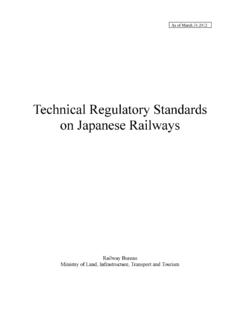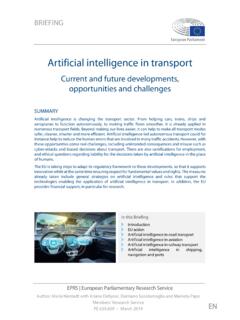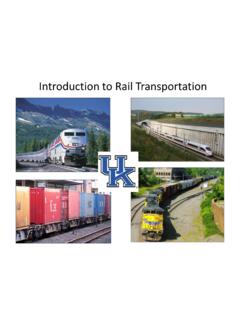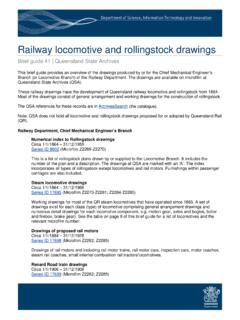Transcription of Level Crossings: A guide for managers, designers and ...
1 Railway Safety Publication 7 December 2011 Level Crossings: A guide for managers, designers and operators Office of Rail Regulation | December 2011 | Level crossings: a guide for managers, designers and operators 2 Contents Foreword 4 What is the purpose of this guide ? 4 Who is this guide for? 4 Introduction 5 Why is managing Level crossing risk important? 5 What is ORR s policy on Level crossings? 5 1. The legal framework 6 Overview 6 Highways and planning law 7 2. Managing risks at Level crossings 9 Introduction 9 Level crossing types basic protection and warning arrangements 12 General guidance 15 Gated crossings operated by railway staff 16 Barrier crossings operated by railway staff 17 Barrier crossings with obstacle detection 19 Automatic half barrier crossings (AHBC) 21 Automatic barrier crossings locally monitored (ABCL) 23 Automatic open crossings locally monitored (AOCL) 25 Open crossings 28 User worked crossings (UWCs) for vehicles 29 Footpath and bridleway crossings 30 Foot crossings at stations 32 Provision for pedestrians at public vehicular crossings 32 Additional measures to protect against trespass 35 The crossing 36 Gates, wicket gates and barrier equipment 39 Telephones and telephone signs 41 Miniature stop lights (MSL) 43 Traffic signals, traffic signs and road markings 44 3.
2 Level crossing order submissions 61 Overview and introduction 61 Office of Rail Regulation | December 2011 | Level crossings: a guide for managers, designers and operators 3 Background and other information on Level crossing management 61 Level crossing orders: scope, content and format 62 Level crossing order request and consideration process 64 Information for local traffic and planning authorities 68 Requiring a request for a Level crossing order 70 Relevant legislation and publications 70 Appendix A - Common terms 72 Appendix B - Limitation on road and rail traffic at AOCL 74 Appendix C - Definition of viewing zone at open crossings 76 Appendix D - Train pedestrian value (TPV) calculation 78 Appendix E - ORR Level crossings team Contact details 79 Appendix F - Level Crossings Act 1983 80 Appendix G - Supporting documentation - Level crossing order assessment checklist 83 Major works at existing Level crossings, including change in protection method, complete renewal or major modernisation 83 Practical guidance on recording assessment findings 83 Minor works at existing Level crossings 86 Appendix H - Legislation and publications 87 Legislation 87 Publications 88 Office of Rail Regulation | December 2011 | Level crossings: a guide for managers, designers and operators 4 Foreword What is the purpose of this guide ?
3 1. The Office of Rail Regulation (ORR) has issued this guidance after extensive consultation. It provides general guidance on the safe management, operation, modification and use of Britain s Level crossings. It also provides detailed information on the Level crossing order making process which is managed by ORR. It updates earlier guidance (RSPG2E), in particular to align it with developments in industry standards and with recommendations from the Rail Accident and Investigation Branch (RAIB). 2. Please note that it is intended to be used as guidance. Following the guidance is not compulsory and you are free to take other action. The guidance aims to help people involved in the management and operation of Level crossings to understand the associated risks and responsibilities 3. We expect Level crossing risks to be controlled to the appropriate degree. If innovative or alternative ways of doing things emerge as ways of properly controlling risk, then this guidance should not hinder their introduction.
4 4. ORR wants its advice on Level crossing safety to be accessible to everyone who has a role to play in making Level crossings safer and more efficient. Who is this guide for? 5. This document is for people who design, install, maintain and operate Level crossings. It may be of interest to others who use or are affected by the use of Level crossings. 6. Interested parties may include any of the following: (a) railway infrastructure managers; (b) highway authorities; (c) road authorities; (d) p lanning authorities; (e) train and station operators; (f) landowners (g) Level crossing users, including groups representing motorists, cyclists, ramblers and persons with reduced mobility. 7. This guidance does not apply to tramways, as the characteristics of tramway crossings and the principles of tramway operation are different. 8. If in doubt, you should contact ORR for advice about how to interpret and apply this guidance to particular circumstances.
5 The guidance will be regularly updated and the version on the ORR website shows the date of the latest update. Ian Prosser Director, Railway Safety Office of Rail Regulation | December 2011 | Level crossings: a guide for managers, designers and operators 5 Introduction Why is managing Level crossing risk important? 1. Level crossings account for nearly half of the catastrophic train accident risk on Britain s railways . ORR believes that the safe design, management and operation of Level crossings can reduce the risks, have a positive effect on user behaviour and so reduce the number of fatal and serious incidents. What is ORR s policy on Level crossings? 2. ORR seeks to influence duty holders and others to reduce risk at Britain s Level crossings. It does this through a variety of means ranging from advice to formal enforcement action. ORR checks that preventive and protective measures are implemented in accordance with the principles of prevention set out in the Management of Health and Safety at Work Regulations 1999.
6 Risk control should, where practicable, be achieved through the elimination of Level crossings in favour of bridges, underpasses or diversions. Where elimination is not possible, ORR aims to ensure that duty holders reduce risk so far as is reasonably practicable and in accordance with the principles of protection. 3. As the safety regulator for Britain s railways , ORR s role is to provide clear advice and enforce relevant legislation including that which relates to Level crossings. We also exercise the powers of the Secretary of State in making Level crossing orders under the Level Crossings Act 1983. The Agency Agreement made between the Secretary of State for Transport and the Office of Rail Regulation relates to functions which ORR has agreed to perform on behalf of the Secretary of State. The Agreement is on ORR s website at 4. ORR believes that it is neither effective nor efficient for only rail companies to be responsible for managing safety at Level crossings.
7 Decisions about Level crossings should involve rail companies, traffic authorities and other relevant organisations as early on as possible. Relevant authorities should recognise the wider benefits that safety improvements at Level crossings (for example, replacing them with bridges) can bring about, particularly for road users. If wider benefits can be achieved, the appropriate funding bodies should agree on how the costs of making safety improvements will be met. 5. ORR is also committed to helping people understand the importance of the safe use of Level crossings. The Using Level Crossings Safely guidance is available on ORR s website. Office of Rail Regulation | December 2011 | Level crossings: a guide for managers, designers and operators 6 1. The legal framework Overview The law relating to Level crossings is not straightforward as there is a need to balance the interests of and rail, and take account of the impact of local circumstances that affect the use of the crossing.
8 The law applying to Level crossings has evolved over the past 160 years. No single government controls all Level crossing legislation. Currently, laws relating to the highways, railways and health and safety apply. The Law Commission for England and Wales and the Scottish Law Commission are undertaking a joint of the existing law governing Level crossings. Check their website for the latest position at: Duties are placed on a number of bodies and individuals including: (a) railway infrastructure managers; (b) Level crossing operators; (c) highway, road and traffic authorities; (d) employers and employees; (e) train and freight operators; (f) land owners; (g) road users; and (h) other crossing users ORR is the enforcing authority for railway health and safety legislation. The key pieces of legislation that operators and users of Level crossings should be familiar with are: Health and Safety at Work etc.
9 Act 1974 is the primary piece of legislation covering occupational health and safety in Great Britain. It requires undertakings to manage and control risks arising from their work activities in connection with Level crossings, so far as is reasonably practicable. It also gives ORR inspectors the powers to inspect and enforce safety at Level crossings. The Management of Health and Safety at Work Regulations 1999 require employers to carry out risk assessments, make arrangements to implement necessary measures, appoint competent people and arrange for appropriate information and training. Level Crossings Act 1983 enables the Secretary of State for Transport to make orders that take account of both safety and convenience aspects of crossings. The order can specify the protection arrangements required at certain types of crossing. Detailed advice on the Level crossing order process can be found in Chapter 3. Office of Rail Regulation | December 2011 | Level crossings: a guide for managers, designers and operators 7 Transport and Works Act 1992 enables the Secretary of State for Transport to make orders that authorise the construction of a railway in England, including allowing it to cross the highway by means of a Level crossing.
10 The authorisation of railway schemes wholly in Wales is by way of an order made by Welsh Ministers. Cross-border rail schemes are authorised by orders made by the Secretary of State subject to the agreement of Welsh Ministers. For Scotland, the Transport and Works (Scotland) Act 2007 enables Scottish Ministers to make orders that authorise the construction of a railway in Scotland, including allowing it to cross the highway by means of a Level crossing. Prior to these Acts being made, crossings would have been authorised either by orders made under the Light railways Act 1896 or under Private Acts. Level Crossings Regulations 1997 make it an offence for a crossing operator to fail to comply with a Level crossing order. railways and Other Guided Transport Systems (Safety) Regulations 2006 (ROGS), as amended by The railways and Other Guided Transport Systems (Safety) (Amendment) Regulations 2011, require all infrastructure managers to have a safety management system that enables them to control risk including risk arising from Level crossings.







